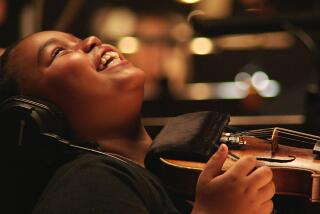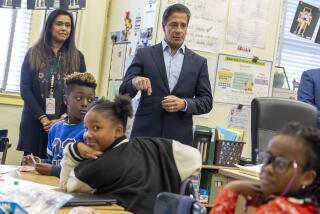Auto Tech Academy Helps Put Teens Back on Track
The last of Robert McCarroll’s students hustled in a few minutes before 10 a.m. to avoid being late. Valvoline motor oil flags hung from the classroom ceiling and protective eyeglasses dangled around the teenagers’ necks. Everyone was wearing a grease-stained jumpsuit.
“All right, let’s go to work,” McCarroll said after checking off the attendance list. His firm words let loose a controlled rush for the door as the students in San Clemente High School’s Auto Tech Academy spilled into their preferred learning arena -- the garage.
Already trained in the basics of radiator flushes, air-conditioning tweaks and spark plug replacements as sophomores and juniors, these seniors turned to more complicated matters.
One pair huddled over a simulated circuit system for a car’s lights, practicing for an upcoming trouble-shooting competition in New York. In the lot outside, Ricky Paquette hooked a hand-held scanning device to his Ford Ranger to run diagnostic tests on the computer systems that run today’s automobiles.
A far cry from the shop classes of yesteryear, San Clemente High’s academy is one of a relatively few programs throughout the country preparing public high school students for work in the understaffed, high-tech auto repair job market. More than that, McCarroll’s program has offered a second chance to hundreds of students who struggled in traditional classrooms -- many of whom say they would have otherwise dropped out.
“I never paid attention in classes and didn’t want to try. But the academy gave me a reason to get my grades up,” said Paquette, 18. The lanky teen pointed toward McCarroll and added, “This is a family. He’s our dad away from home.”
The auto program operates as a smaller self-contained school within San Clemente High. Since 1998, the academy has admitted 35 new sophomores each year -- often from a pool of more than 100 applicants -- into a curriculum that integrates vocational training with traditional academics. Most are boys, but one or two girls typically enroll as well.
The auto tech program is one of 290 state-supported “partnership academies” that cover a wide range of disciplines in high schools throughout California. Sacramento funds as much as $81,000 -- about a third -- of an academy’s annual budget, with local districts and private contributors covering the rest.
Started in 1993, California’s academy programs grant regular high school diplomas, but also provide the opportunity for gaining experience in a trade. San Clemente is one of two auto academies. Other academies are devoted to agriculture, construction and electronics.
Students at the auto academy manage a full course load of math, science, English and history, along with the increasingly complex auto classes that meet four times a week. Sophomores study basic mechanics, juniors dissect the donated cars’ various systems, and seniors finish with advanced diagnostics.
State regulations require that at-risk students -- those who have either struggled badly in traditional classes or come from impoverished families -- make up at least half of each academy class. So, McCarroll does not look at academic prowess or experience, but desire and a passion for cars. “If you’re willing to commit to me,” he says, “I am willing to commit to you.”
McCarroll does not make such offers lightly. Unexcused absences or excessive lateness are grounds for expulsion. Students must sign a contract agreeing to standards of behavior. A student who fails an auto class is kicked out and any other failing grades must be made up at summer or night school.
In exchange, McCarroll; his assistant, Kathy Itzel; and a team of tutors work to keep students on track to graduate while lining up the summer internships, job shadowing and industry mentors that are requirements of the academy system.
For some it is a bad fit, and every year a few drop out or fail. But for many students, the program was a salvation. Sal Arredondo, 17, spent much of the first year ditching classes to hang out with the “wrong crowd.” After finishing with three Ds and two Fs, he was on the verge of dropping out.
“At the academy, I realized there was something to come to school for. It’s my joy. I would have homework that I didn’t want to do, but I knew I wanted that jacket,” Arredondo said, referring to the suede jackets awarded to academy juniors who are on schedule to graduate. “My friends would tell me not to go to class, but I wanted that jacket. If I hadn’t gone to the academy, I’d probably be working my butt off as a gardener somewhere. I wouldn’t be in school.”
Arredondo spent last summer working on transmissions as a technician’s assistant at Barwick Motors in San Juan Capistrano, and now works there part time after school. When Arredondo graduates, said Barwick’s service director, Norman Amabile, the dealership plans to hire him full time and pay for him to attend a postsecondary technician class.
The dozens of dealerships and repair shops that donate to the academy and provide internships are hardly acting out of altruism. With technology in cars becoming more complex, experts say the industry is starved for well-trained mechanics.
“These kids are our future employees,” Amabile said. “There is a great need for them and we want to groom them the way we want. The academy kids come in already with some training, which is a blessing.”
Likewise, Peter Egus, national manager for service technicians at Hyundai, said the manufacturer had donated cars to McCarroll’s academy and others to help counter the persistent decline in high school auto-tech programs. Although national figures are not compiled, Egus estimated that the number of high school auto-repair programs in the country had dropped by about half over the last 10 years as schools decided they could not afford the new equipment.
The trend is especially frustrating for an educator such as McCarroll, who expressed concern that schools were too quick to abandon vocational training.
A national study released this month indicated that students who attended career academies were as likely to attend college as non-academy students and, on average, earned more in the work force.
That is especially true in the automobile industry, where entry-level salaries for tech-savvy mechanics begin at around $60,000 a year and more experienced workers can earn $100,000 or more.
“We’re not just grease monkeys anymore,” Paquette said.







